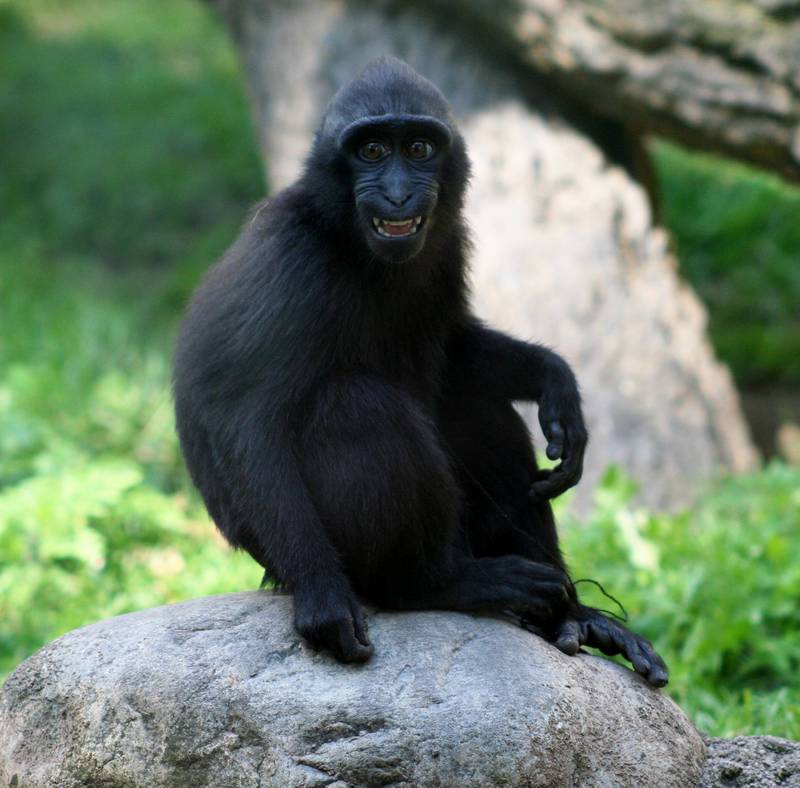|
| Query: Caterpillar | Result: 1535th of 1696 | |
Celebes Crested Macaque (Macaca nigra) - Wiki
| Subject: | Celebes Crested Macaque (Macaca nigra) - Wiki
| |

| Resolution: 2328x2292
File Size: 487565 Bytes
Date: 2006:06:12 16:26:58
Camera: Canon EOS DIGITAL REBEL XT (Canon)
F number: f/4.0
Exposure: 1/250 sec
Focal Length: 130/1
Upload Date: 2007:08:14 11:34:13
|
Celebes Crested Macaque
From Wikipedia, the free encyclopedia
[Photo] A juvenile Sulawesi Crested Macaque (Macaca nigra), at the Buffalo Zoo (Buffalo, NY). Date 12 June 2006. Author Dave Pape http://commons.wikimedia.org/wiki/User:Davepape
The Celebes Crested Macaque (Macaca nigra), also known as the Crested Black Macaque, Sulawesi Crested Macaque, or the Black "Ape", is an Old World monkey that lives in the northeast of the Indonesian island of Sulawesi (Celebes) as well as on smaller neighboring islands.
Its skin and hairless face is, with the exception of some white hair in the shoulder range, entirely jet black. The long muzzle with high cheeks and the long hair tuft, or crest, at the top side of the head are remarkable. The tail is only approximately 2 cm of stub. With a total body length of 45 to 60 cm and a weight of 7 to 10 kg, it is one of the smaller macaque species.
The Celebes Crested Macaque is a diurnal rain forest dweller. This macaque is primarily terrestrial, spending more than 60% of its day on the ground foraging for food and socializing, while sleeping and searching for food in the trees.
It lives in groups of 5 to 25 animals. Smaller groups have only a single male, while larger groups have up to four males. The females, however, always outnumber the males by about 4:1. Since young males must leave their birth group upon maturity, they sometimes form bachelor groups before they look for a connection to an existing mixed group. Communication consists of various sounds and gestures; such as the presentation of the long eyeteeth while grimacing a clear threatening gesture.
The Celebes Crested Macaque is frugivorous, with 70% of its diet consisting of fruits. It also consumes leaves, buds, seeds, fungus, birds and bird eggs, insects (such as caterpillars), and the occasional small lizard or frog.
The Celebes Crested Macaque is promiscuous, with both males and females mating multiple times with multiple partners. The receptivity of the females is clearly indicated by a tumescence (swelling) and redness which, in contrast to the black skin color, is particularly remarkable. The gestation time is 174 days, and the birth of the usually single offspring happens in the spring when food is more plentiful. Young animals are nursed approximately one year and become fully mature in 3 to 4 years, females somewhat sooner than males. Its life expectancy is estimated at approximately 20 years.
The Celebes Crested Macaque is hunted sometimes both as pests, because it devastates crops and fields, and as bushmeat. Clearing the rain forests represents an additional problem. Its situation on the small neighbour islands of Sulawesi (such as Bacan) is somewhat better, since these are hardly settled. The total population of the macaque on Sulawesi is estimated at 4,000-6,000, while a booming population of up to 100,000 monkeys is found on Bacan.
http://en.wikipedia.org/wiki/Celebes_Crested_Macaque
| The text in this page is based on the copyrighted Wikipedia article shown in above URL. It is used under the GNU Free Documentation License. You may redistribute it, verbatim or modified, providing that you comply with the terms of the GFDL. |
|
Comments |
|---|
| | Guest |
|
| The Celebes crested macaque (Macaca nigra), also known as the crested black macaque, Sulawesi crested macaque, or the black ape, is an Old World monkey that lives in the Tangkoko reserve in the northeastern tip of the Indonesian island of Sulawesi (Celebes), as well as on smaller neighboring islands. Macaca nigra lives typically in groups of five to twenty-five animals, and occasionally in groups of up to seventy-five animals. |
^o^
Animal Pictures Archive for smart phones
^o^
|
|
|

